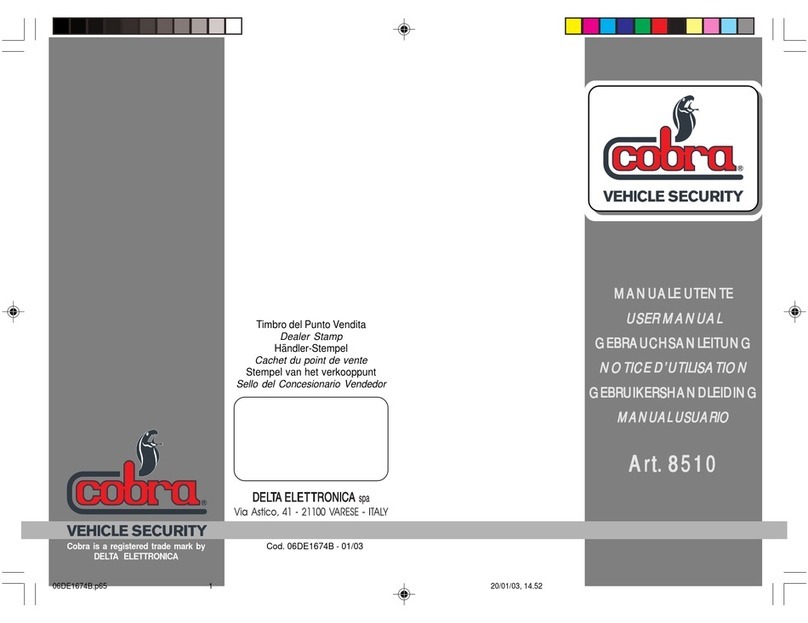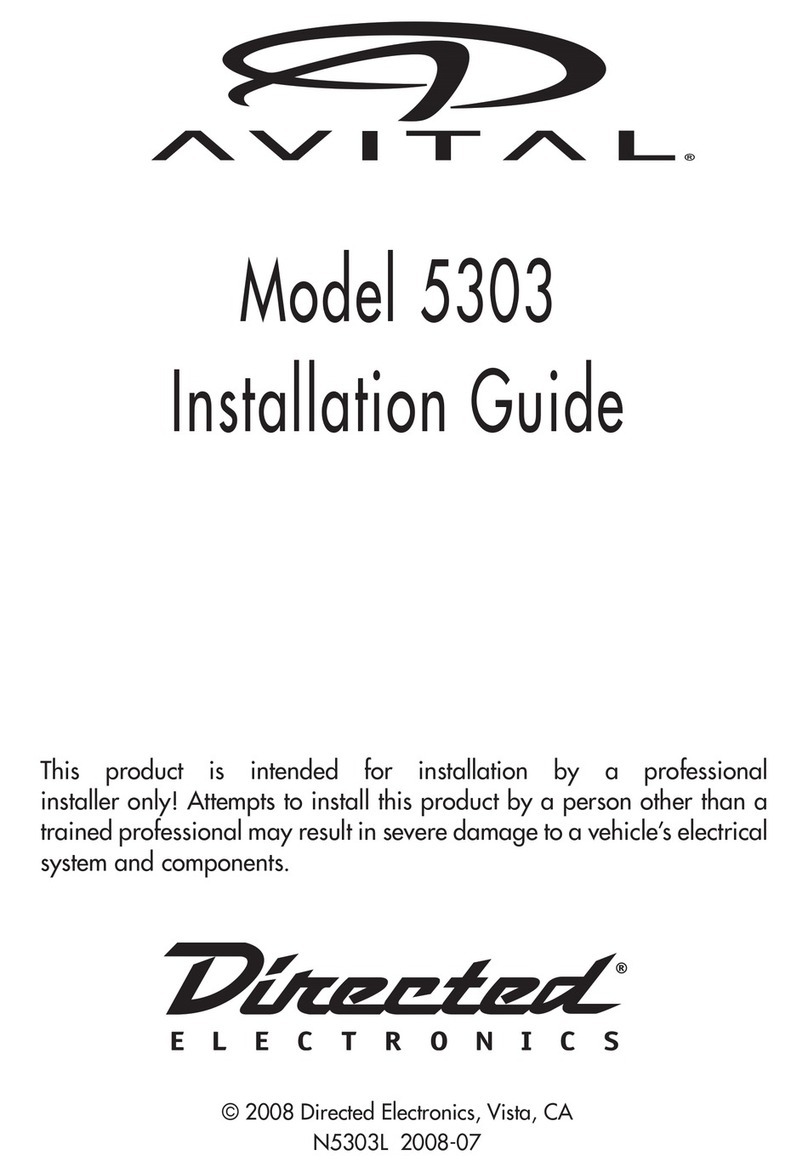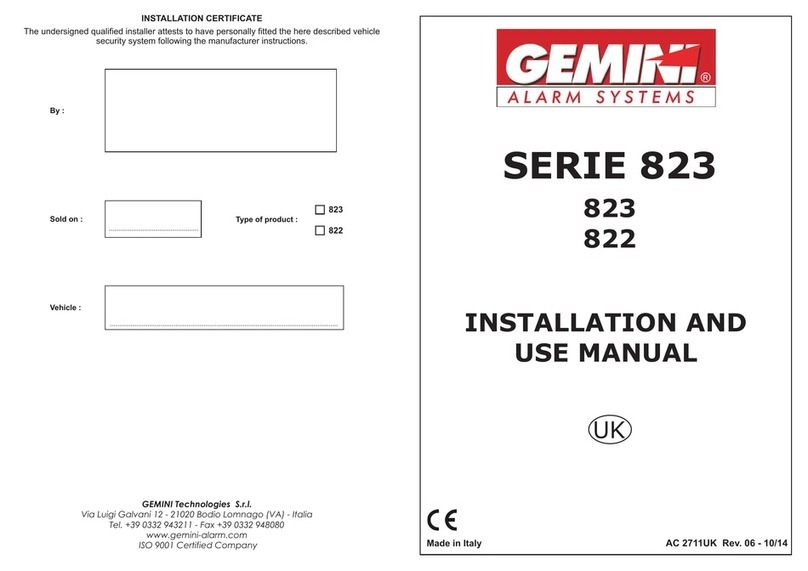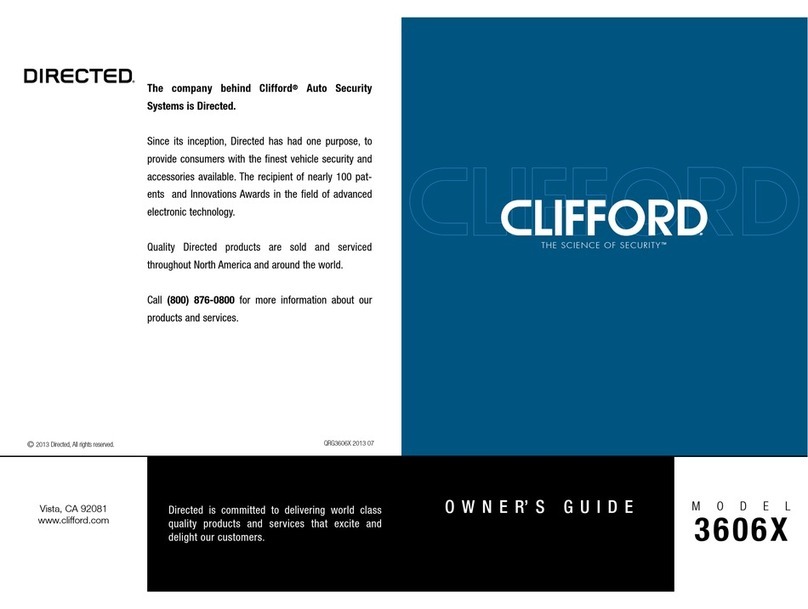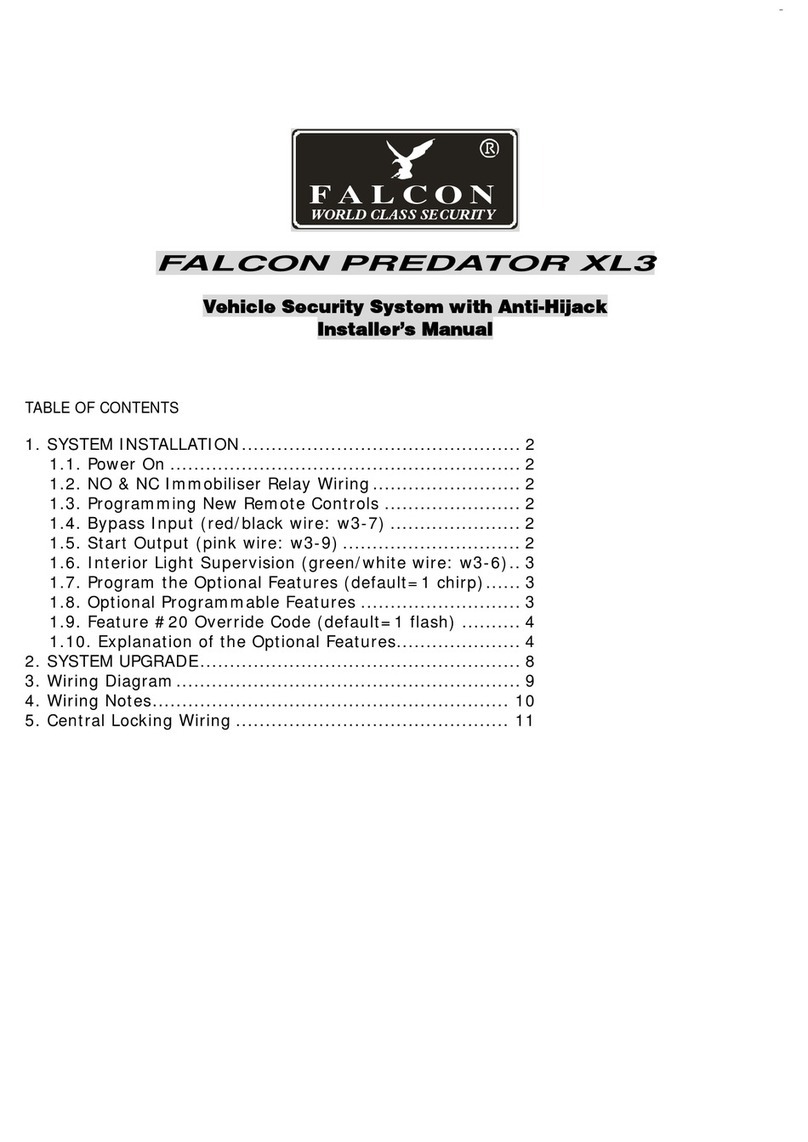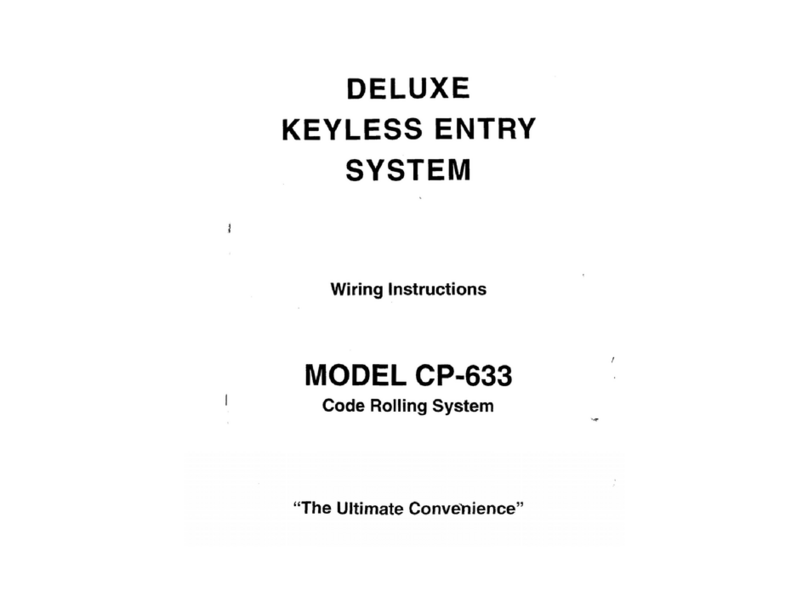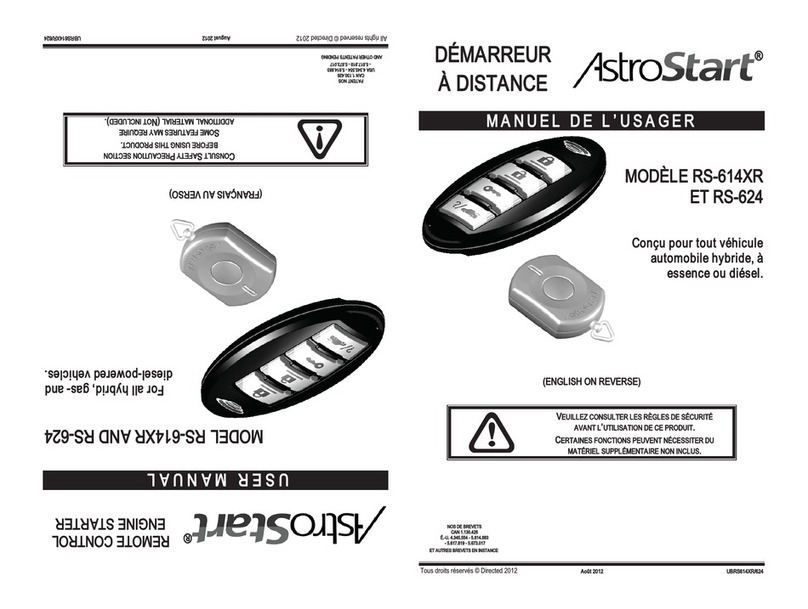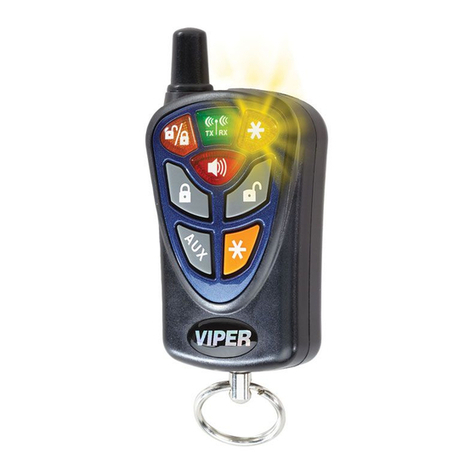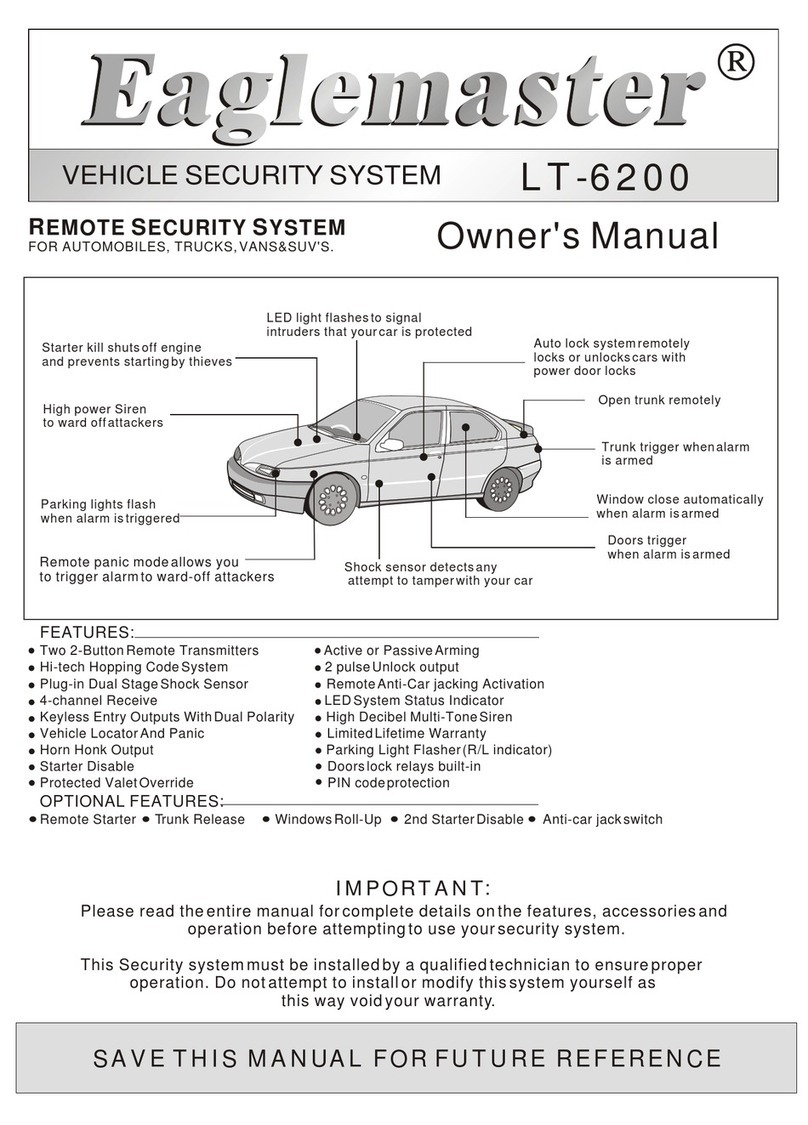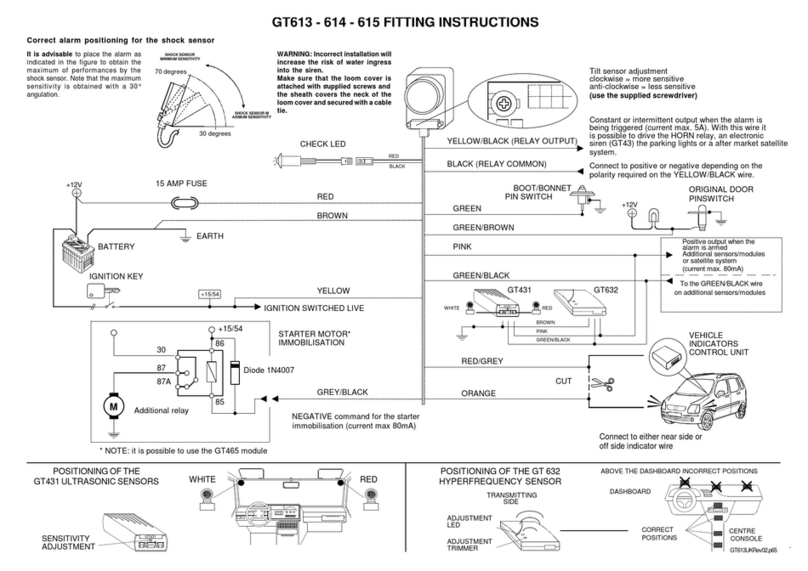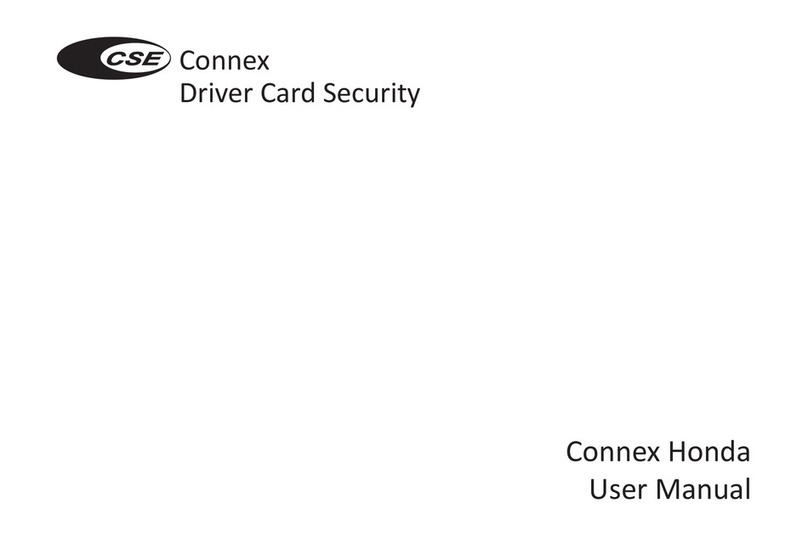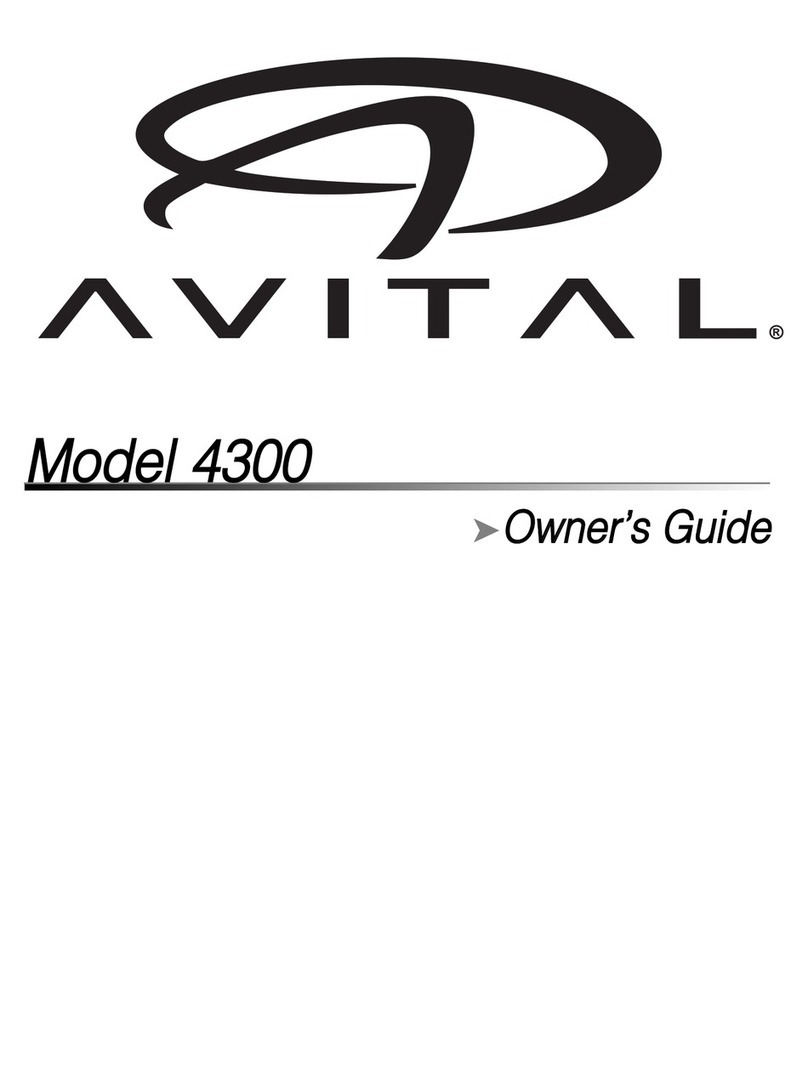Cobra 4600 CAN User manual

4600 CAN/PLIP
INSTALLATION MANUAL

INSTALLATION MANUAL 4600 CAN/PLIP
2
Summary
1.KIT CONTENTS.................................................................................................................................................3
2. INTRODUCTION & INSTALLATION METHODOLOGY (how to access to the vehicle specific technical
documents, Data Linker tool, Antares software, how to define the installation solution) ......................................3
3.SYSTEM’S CONFIGURATION..........................................................................................................................4
4. HOW TO PREPARE PIN CODE CARD............................................................................................................5
5.INSTALLATION PROCEDURE (system’s component locations, electrical connections) .................................5
6.ACTIVE FUNCTIONALITIES (descriptions) .....................................................................................................8
- ELECTRIC DIAGRAMS
7.PROGRAMMABLE FUNCTIONS (descriptions) ............................................................................................18
8. HOW TO PROGRAM FUNCTIONALITIES, COBRA REMOTE CONTROLS AND DRIVER CARDS SELF
LEARNING PROCEDURE ................................................................................................................................20
9. FUNCTIONAL TEST.......................................................................................................................................21
10. CAN INDEX MANUAL SELECTION .............................................................................................................21
11. SELF LEARNING PROCEDURE REQUIRED TO REPLACE THE MAIN UNIT OR THE WIRELESS SIREN
REPLACEMENT. ................................................................................................................................................22
12. DOCUMENTS HANDOVER .........................................................................................................................22
13. TECHNICAL FEATURES..............................................................................................................................22
14. UK MARKET.................................................................................................................................................23

INSTALLATION MANUAL 4600 CAN/PLIP
3
1. - KIT CONTENTS.
The following are the main parts supplied in the kit:
- Main alarm unit.
- Remote controls and/or Driver Card (if provided).
- Wireless back-up battery siren or wired siren, loudspeaker.
- Main unit universal wiring harness.
- Siren wiring harness.
- Siren bracket.
- Ultrasonic sensors.
- Installation accessories.
- LED / control button.
- Quick reference user manual.
- Pin Code card.
2. - INTRODUCTION.
The main unit of this system is equipped with an on board CAN interface (Controller Area Network) that allows the
data reading from the vehicle CAN network. In can also be installed configured as PLIP, with this solution the unit is
not connected to the CAN network, but to the central door locking motors, to the door locking switches and/or to the
direction lights.
It can be armed/disarmed by the vehicle original remote control, with the Cobra one or with the Driver Card (if provided).
This manual contains all information required to fit the system on 12V battery vehicles with the negative pole connected
to the vehicle body.
HOW TO ACCESS TO THE VEHICLE SPECIFIC TECHNICAL DOCUMENTS, DATA LINKER TOOL, ANTARES
SOFTWARE.
Access to the web site www.cobra-at.com > Installer area and register yourself to be allowed to download the technical
documentation.
Data Linker programming tool and the software “Antares” are required to customize the product for the destination vehicle.
Data Linker is composed by a USB interface module, a 12V DC power supply, a CD containing the software “Antares”
and the required instructions. Product specific wiring harness are also supplied to connect the USB module to the
product main unit.
Antares allows to configure/customize and to program the CAN/PLIP software for the destination vehicle using your
computer.
HOW TO DEFINE THE INSTALLATION SOLUTION.
Access to the web site www.cobra-at.com > Login > user ID > password > access > professional area and, clicking
on the menu, supply all the requested destination vehicle information (in the example a VW Polo, year 2011) as the
information of the product to install, in this case the 4600 range.
VEHICLE TYPE.
Auto - Car
PRODUCT TYPE.
Antifurti auto - Car alarms
BRAND LIST.
Volkswagen
MODEL LIST.
Polo

INSTALLATION MANUAL 4600 CAN/PLIP
4
The list on the right side of the screen shows the product families. Clicking on the link you will get the full application list
available for the destination vehicle for the product family selected. Check at first if there is a CAN application available,
it offers the best compromise amoung functionalities offered/fitting time.
If no one CAN product installation proposal is available, make the same research clicking on “PLIP alarm” range
AK4600 – 4400 Plip.
If there is an installation solution clicking on the vehicle model you can download the vehicle specific installation sheet.
If no one CAN and no one Plip installation proposal is available, choose again the vehicle type then, as “Product type”
select “Application manuals”. The list on the right side of the screen shows the application manuals available, click
on “Application manuals” to get the application manual list, then download the installation manual of the 4600 for the
Plip configuration.
3. - SYSTEM’S CONFIGURATION.
Be sure to have connected all Data Linker components and to have power supplied the system.
Run Antares.
As soon as Antares is starting, it automatically checks - if the computer is connected to internet - if the installed version
is the most updated one and, if not, it proposes its update.
We recommend to download all times the last update.
Proceed as follow:
A. Select the language.
B. Select “alarm and modules”.
C. Select product “4600 “ as “1 wire” or “2 wire”.
D. Select the procedure “firmware update”.
E. Click on “proceed”.
F. Select the vehicle brand.
G. Select the vehicle model.
H. Select the vehicle model year.
I. Click on “proceed”.
L. Confirm and continue.
M. Wait until the programming confirmation window appears.
Additional software installation and tool usage details are available on the specific manual supplied in the Data Linker
kit or in the Cobra web site, professional area, Application manuals.

INSTALLATION MANUAL 4600 CAN/PLIP
5
4. - HOW TO PREPARE THE PIN CODE CARD.
Remove the separate PIN Code label from the back of the system main unit and place onto the supplied PIN Code Card.
www.cobra-at.com
PLACE HERE THE PIN
CODE LABEL
PERSONAL IDENTIFICATION
CODE
4C4415A2A
S/N 0003 050524
PIN
CODE 1122
5. - INSTALLATION PROCEDURE.
System’s component positioning.
As much as the components of the system will be placed in secure and difficult to access positions as higher the
protection level will be.
WARNING: each element must be positioned so that it does not interfere with moving parts.
Alarm unit.
It must be fitted inside the vehicle far away from heating sources, paying attention to keep the main connector oriented
down.
Siren.
It can be installed in the engine bay as inside the vehicle far away from heating sources paying attention to keep the
main connector oriented down.
Ultrasonic volumetric sensor.
The ultrasonic transducers must be fixed to the top of the A pillars pointed towards the rear window or to the top of the
C pillars pointed towards the windscreen. Their orientation should be as much as possible parallel to the side windows.
Emergency LED/control button
It must be fitted on the dashboard with its LED in a in sight position. The pushbutton should be easily accessible by
the driver.
Bonnet pushbutton.
The installation of the supplied pushbutton is required if the vehicle is not yet equipped with the original one. The specific
vehicle CAN/PLIP installation sheet supplies this info.

INSTALLATION MANUAL 4600 CAN/PLIP
6
Antennas.
The RF antennas positioning (for both the main unit and the siren) is crucial for a proper system’s performance . They
must not be cut, wrapped, connected to any other cables or to the vehicle body and they must be kept separate from
the main wiring harness and as far as possible from metallic parts.
Electrical connections.
WARNING: Disconnect the negative lead from the battery before continuing with the installation.
Pay attention when joining two or more wires. Avoid to make “quick connections” that do not ensure a good quality.
Also make sure that the wires of the Cobra 4600 are routed so that they follow the original wiring of the vehicle to which
they should be joined with the raps.
The addition of fuse is required as specified in the main connection diagram.
26 ways connector J pin-out for CAN configurations
J-1 and J-2 Engine crank inhibition: to get the maximum security level to the system connect the two wires as shown
in the electrical diagrams to prevent the engine starter running.
During the cranking phase, measure the value of the current in the circuit
that has been interrupt, to make sure that it does not exceed the technical specifications of the product.
Install an additional relay if required.
J-3 Logic blinker output: make the connection if required by the specific vehicle CAN installation sheet.
J-4 Power blinker output: make the connection if required by the specific vehicle CAN installation sheet.
J-5 Logic blinker feedback input or power blinker output: make the connection if required by the specific
vehicle CAN installation sheet.
J-6 analogic input: make the connection if required by the specific vehicle CAN installation sheet.
J-7 analogic input:make the connection if required by the specific vehicle CAN installation sheet.
J-8 Cobra bus: communication line for the connection of compatible Cobra sirens and sensors.
J-9 and J-10 CAN H/L: to connect as shown in the specific vehicle CAN installation sheet.
J-11 Pager negative output: low power control signal for triggering a pager device or a telematic one. Active low during
alarm time.
J-12 CDL unlock negative output: low power control signal to unlock central door locking.Activated by the Cobra remote
control , if provided (see electrical diagram F).
J-13 analogic input: make the connection if required by the specific vehicle CAN installation sheet.
J-14 12V connection (+30): the positive supply must be connected to a vehicle positive connection point upstream of the
fuse box. Fit a 15A fuse as close as possible to the connection point.
J-15 GND connection: the ground must be connected to a factory earth point or directly to the negative pole of the battery.
J-16 Negative output for modules: active when the system is armed. To be used for the connection of compatible
Cobra modules.
J-17 Horn/loudspeaker negative output: to program in line with the connected device. See electric diagrams and
functionalities programming tables. The output set automatically as per selected device, for horn choose also fix or intermittent.
J-18 Positive input: when connected to positive it disables permanently the automatic ultrasonic protection exclusion
normally working when windows are left open.
J-19 analogic input: make the connection if required by the specific vehicle CAN installation sheet.
J-20 analogic input: make the connection if required by the specific vehicle CAN installation sheet.
J-21 negative input to enter in programming procedure/to connect bonnet pushbutton: if connected to
ground the system will enter in the programming procedure for all applications not able to detect the original bonnet pushbutton.
If the siren is a wireless one this input must not be used for the bonnet pushbutton connections. For wired siren or loudspeaker
this input must be used for the connection of the bonnet pushbutton as indicated in the specific vehicle CAN installation sheet.

INSTALLATION MANUAL 4600 CAN/PLIP
7
J-22 Do not connect.
J-23 Negative input for additional modules: to be used as a triggering input for the connection of compatible Cobra
modules.
J-24 Do not connect.
J-25 CDL lock negative output: low power control signal to lock central door locking. Activated by the Cobra remote
control , if provided (see electrical diagram F).
J-26 analogic input: make the connection if required by the specific vehicle CAN installation sheet.
26 ways connector J pin-out for PLIP configurations
J-1 and J-2 Engine crank inhibition: to get the maximum security level to the system connect the two wires as shown
in the electrical diagrams to prevent the engine starter running.
During the cranking phase, measure the value of the current in the circuit
that has been interrupt, to make sure that it does not exceed the technical specifications of the product.
Install an additional relay if required.
J-3 Logic blinker output: make the connection if required by the specific vehicle PLIP installation sheet.
J-4 Power blinker output: make the connection if required by the specific vehicle PLIP installation sheet.
J-5 Logic blinker feedback input or power blinker output: make the connection if required by the specific vehicle
PLIP installation sheet.
J-6 Blinker inhibition positive input: to connect as indicated in the specific vehicle PLIP installation sheet or in the
product installation guide for PLIP applications available on the web under Application manuals.
J-7 Negative input for CDL opening switch signal: to connect as indicated in the specific vehicle PLIP installation
sheet or in the product installation guide for PLIP applications available on the web under Application manuals.
J-8 Cobra BUS: communication line for the connection of compatible Cobra sirens and sensors.
J-9 and J-10 Do not connect.
J-11 Pager negative output: low power control signal for triggering a pager device or a telematic one. Active low during
alarm time.
J-12 CDL unlock negative output: low power control signal to unlock central door locking. Activated by the Cobra remote
control , if provided (see electrical diagram F).
J-13 Positive input for CDL motor opening signal: to connect as indicated in the specific vehicle PLIP installation
sheet or in the product installation guide for PLIP applications available on the web under Application manuals.
J-14 12V connection (+30): the positive supply must be connected to a vehicle positive connection point upstream of the
fuse box. Fit a 15A fuse as close as possible to the connection point.
J-15 GND connection: the ground must be connected to a factory earth point or directly to the negative pole of the battery.
J-16 Negative output for modules: active when the system is armed. To be used for the connection of compatible
Cobra modules.
J-17 Horn/loudspeaker negative output: to program in line with the connected device. See electric diagrams and
functionalities programming tables. The output set automatically as per selected device, for horn choose also fix or intermittent.
J-18 +15/54 connection: to be connected to a ignition key ON positive signal. The positive signal must be feeded while
starting the vehicle and when the engine is ON.
J-19 Negative input for CDL closing switch signal: to connect as indicated in the specific vehicle PLIP installation
sheet or in the product installation guide for PLIP applications available on the web under Application manuals.
J-20 Do not connect.
J-21 negative input to enter in programming procedure/to connect bonnet pushbutton: if connected to
ground the system will enter in the programming procedure for all applications not able to detect the original bonnet pushbutton.
If the siren is a wireless one this input must not be used for the bonnet pushbutton connections. For wired siren or loudspeaker
this input must be used for the connection of the bonnet pushbutton as indicated in the specific vehicle PLIP installation sheet.

INSTALLATION MANUAL 4600 CAN/PLIP
8
J-22 positive/negative perimetric input: to be connected to the vehicle roof lamp. The system configures automatically
the input polarity 10 s after it has been armed. Make the functional test of the system after is has been configured.
J-23 Negative input for additional modules: to be used as a triggering input for the connection of compatible Cobra
modules.
J-24 Do not connect.
J-25 CDL lock negative output: low power control signal to lock central door locking. Activated by the Cobra remote
control , if provided (see electrical diagram F).
J-26 Positive input for CDL motor closing signal: to connect as indicated in the specific vehicle PLIP installation
sheet or in the product installation guide for PLIP applications available on the web under Application manuals.
MAKE CONNECTIONS AS FOR ELECTRIC DIAGRAMS
6. - ACTIVE FUNCTIONALITIES.
6.1 - Interior protection with ultrasonic volumetric sensor.
The system protects the vehicle interior with a volumetric ultrasonic sensor. Any attempt to get into the vehicle will be
detected and the alarm will trigger.
6.2 - Perimetric protection with door open warning diagnostic.
The alarm will trigger by opening any door, boot and bonnet. Should you have left any door opened while arming, the
system will signal it by 3 flashes of the direction lights and 3 audible signals (5 audible signals if the arming/disarming
audible signals function has been activated).
6.3 - Cable cutting protection (only for systems with back-up battery siren).
The alarm will trigger if the system is not power supplied (cutting of cables - battery disconnection) signalling the sabotage.
6.4 - Engine crank inhibition.
As soon as the system is armed the engine cranking is not possible anymore.
6.5 - Arming the system with the volumetric ultrasonic protection disabled .
This function allows to arm the system leaving temporarily disconnected the interior volumetric protection. The protection
must be disabled any time you leave somebody or an animal in the vehicle. If you want to leave any window opened
also disable the protection to avoid false alarms. All other protections remain active.
To disable the volumetric protection proceed as follow:
switch the engine off being sure that the ignition switch has been turned to the OFF position. Within 5 s press the
emergency panel pushbutton and keep it pressed until it will flash once to confirm only the volumetric protection has
been disabled. By keeping the pushbutton pressed the system will confirm with two flashes that only the additional sensor
input has been disabled, with three flashes for both of them disabled. The selected protection will remain disabled until
the system will be disarmed. It will be automatically restored at the next arming.
Note: on some vehicles the system automatically disables the volumetric protection if any windows is left opened.
Ask your installer if this functionality is provided by the system fitted on your vehicle.

GREEN
WHITE
BROWN
YELLOW
YELLOW-GREEN
YELLOW-WHITE
15 A
3 A
YELLOW-BLUE
BLACK
ORANGE
VIOLET
YELLOW-BLUE
BLACK
RED RED
ORANGE
VIOLET
GREEN
GREY
ORANGE-BLACK
GREY-BLACK
YELLOW-BLACK
VIOLET-BLACK
GREEN-RED
BLUE J21
J8
J15
J9
J10
J14
J4
J5
J3
J1
J2
J17
J16
PINK-WHITEJ6
J23
PINK-BLACK
BLUE-PINK
J20
J22
J19
J7
J26
J13
J18
ORANGE
VIOLET J25
J12
ORANGE-WHITEJ11
VIOLET-WHITE
(NOT USED)
J24
BLACK
BLACK
max 20A (1 sec.)
6A cont.
CAN - H
CAN - L
+30
See Diagram "F"
See he vehicle fi ing
ins ruc ions or he
CAN/PLIP J 26 connec or
pin ou
See he vehicle fi ing
ins ruc ions or he
CAN/PLIP J 26 connec or
pin ou
HAZARD
BLINKER OUTPUT
BLINKER FEEDBACK
BLINKER OUTPUT
BLINKER OUTPUT
POWER
LOGIC
SENSOR
INPUT
46XX Art. (NO WIRELESS SIREN)
SIREN HORN
OUTPUT
START +50
PAGER OUTPUT
SENSOR NEGATIVE
SUPPLY OUTPUT

GREEN
WHITE
BROWN
3 A
BLUE
ORANGE-BLACK
GREY-BLACK
YELLOW-BLACK
BLACK
ORANGE
VIOLET
VIOLET-BLACK
GREEN-RED
RED
ORANGE
VIOLET
GREY
YELLOW
YELLOW-GREEN
YELLOW-WHITE
RED
BLACK
BLUE-PINK
PINK-BLACK
PINK-WHITE
VIOLET
ORANGE
J9
J15
J4
J5
J3
J26
J13
J18
J19
J7
J1
J2
J17
J25
J16
J12
J23
J10
J20
J6
J22
GREEN
ORANGE-WHITEJ11
VIOLET-WHITE
(NOT USED)
J24
BLUEJ14 J21
15 A
Antenna
CAN - H
CAN - L
max 20A (1 sec.)
6A cont.
+30
HAZARD
See "F" Diagram
BLINKER OUTPUT
BLINKER FEEDBACK
BLINKER OUTPUT
+30
See he vehicle fi ing ins ruc ions or he
CAN/PLIP J 26 connec or pin ou
See he vehicle fi ing
ins ruc ions or he
CAN/PLIP J 26 connec or
pin ou
BLINKER OUTPUT
POWER
LOGIC
SENSOR
INPUT
46XX Art. (WIRELESS SIREN)
SIREN HORN
OUTPUT
YELLOW-BLUEJ8
COBRA BUS
START +50
See paragraph 11
PAGER OUTPUT
SENSOR NEGATIVE
SUPPLY OUTPUT

ORANGE
VIOLET
J12
J25
3 A
BLACK
BLACK
OK
PASS
TX LED RX
1N4004
WHITE wire J17
WHITE wire J 17
WHITE wire J 17
EF
C D
G
RED ( TX)
RX
TX
Antenna
RX
TX
U.S. sensors, led
panel and an enna
connec ions.
B
Ins all he jumper wire (see he ca alogue)
be ween he Ul rasound TX and RX, if you don'
use he volume ric sensor.
A
-
-
WHITE
(RX)
Vehicle horn connec ion wi h addi ional relay.
Original
sys em Addi ional
relay
Low power ou pu s for vehicles wi h
nega ive CDL con rol signals.
Original relay con rolled by a nega ive signal.
Vehicle horn connec ion wi h nega ive con rol
signal o he original relay.
87 30 86 85
87 30 86 85
Y
PASS
TX LED RX
Y
123
U S
U S
+30
+
-
15A
+30
- / +
- / +


INSTALLATION MANUAL 4600 CAN/PLIP
17
6.8 - Emergency disarming.
If the vehicle original remote control get lost or if it doesn’t work, open the door with the mechanical key and turn the
ignition key ON. If the system doesn’t disarm automatically follow the emergency procedure described in the user manual.
6.9 - Alarm condition.
When the system goes off (alarm ON) the siren sounds and the direction lights flash for 28 s.
6.6 - Emergency panel LED.
The LED main scope is to show the system arming and disarming conditions. When the system is armed the LED gets
ON and remains illuminated until the 25 s arming period has elapsed. After that it starts blinking. It goes OFF as soon
as the system is disarmed.
6.7 - Alarms memory.
If the system has gone off (alarm on) during the arming time it will warn you with 3 flashes of the direction lights and 3
audible signals (5 audible signals if the arming/disarming audible signals function has been activated). It also stores in
its memory the reason of the occurred alarm and shows it on the emergency panel LED. Count the number of flashes
and check the corresponding alarm reason on the table. By turning the key ON the memory will be deleted.
LED NUMBER OF FLASHES ALARM ROOT CAUSE
1 flash Door opening detection.
2 flashes Ultrasonic volumetric detection.
3 flashes Bonnet opening detection.
4 flashes Ignition key ON detection.
5 flashes Boot opening detection.
6 flashes Door opening detection.
7 flashes Additional sensors.
8 flashes Siren cable cutting - Cobra Bus.
9 flashes US module connected to the Cobra Bus.
10 flashes Module connected to the Cobra Bus.
11 flashes Immobilizer 1 module connected to the Cobra Bus.
12 flashes Immobilizer 2 module connected to the Cobra Bus.
13 flashes Keyboard module connected to the Cobra Bus.
14 flashes Not used.

INSTALLATION MANUAL 4600 CAN/PLIP
18
7. - PROGRAMMABLE FUNCTIONS.
To activate them refer to the “FUNCTIONS PROGRAMMING” table.
7.1 - Activation and volume adjustment of the audible arming and disarming signalling.
This function allows to activate a short duration audible signal to confirm the system’s arming (1 beep) and disarming
(2 beeps).
7.2 - Passive arming.
The system will automatically arm after 30 s the ignition key has been switched off and the driver side door has been
opened and closed, so only 30 s after the driver has left the vehicle.
7.3 - Auto re-arming.
The system will automatically re-arm after 115 s, it has been disarmed and no one door has been opened (nobody
gets on the vehicle).
7.4 - Auto re-arming with doors locking.
As for auto re-arming, but doors will lock (if the CDL connections have been made).
7.5 - Passive engine starting inhibition.
The starting inhibition becomes active after 115 s the engine has been switched OFF. The cranking inhibition is immediately
deactivated if the Driver Card is detected or when a correct emergency PIN Code has been digit on the emergency
panel. This functionality is totally independent from the other ones.
7.6 - Manual or automatic comfort window closing with Cobra remote control.
This is a native function of the vehicle, so at first check if it is available. By keeping pressed the Cobra remote control
pushbutton “A” you can close the windows from a distance in manual mode. If not you can ask your installer to fit an
additional module which allows the closing of windows by pressing and releasing the button “A” in automatic mode.
Warning: for safety reasons we recommend to close the windows remaining close to the vehicle.
7.7 - Anti hi-jacking.
This function prevents the vehicle for being stealing while driving. It has been studied to also guarantee the driver safety.
If the driver is not recognized by the system he will be considered as not authorized to drive the vehicle. The system will
generate an alarm sequence and it will prevent the vehicle to start again after it has been switched OFF.
During the normal usage of the vehicle the driver is recognized by the system in two ways:
- automatic by the Driver Card matched to the system (if provided);
- manual by entering with the emergency panel pushbutton the first two digits of the PIN Code.

INSTALLATION MANUAL 4600 CAN/PLIP
19
The driver recognition must happen any time the ignition key is turned to the ON position or when, with the ignition key
already ON, the driver side door is opened and then closed to get off the vehicle. If the driver is not recognized within
60 s the emergency panel LED starts flashing quickly signalling for the next 30 s the missed driver recognition. When
this time elapses the system starts generating alarm sequences also if the engine is running, so this situation can take
place while the vehicle is driven. The engine starting inhibition will become active as soon as the ignition key is turned to
the OFF position; additional attempt to start the vehicle will not be possible. To interrupt the anti hi-jacking functionality
press once the Driver Card pushbutton or digit the complete emergency PIN Code on the emergency panel pushbutton.
Note: the product is delivered with this function disabled as its usage invalids the product European homologation. It
can be used only for non-european countries where the functionality is not in conflict with the local regulations.
7.8 - Garage mode.
This function allows to temporarily disable all automatic protection functionalities of the system .It can be used, as an
example, when you need to leave the vehicle at a workshop for maintenance to avoid the automatic activation of any
functionality. When the garage function is active the driver is allowed to turn the ignition key on for 10 times (engine
running). After 10 times the system restore all automatic protection functionalities.
Activation
- Open driver side door.
- Turn the ignition key ON.
- Enter the complete emergency PIN Code (4 digits) on the emergency panel pushbutton.
- A flash of the direction lights confirms the activation.
Deactivation
- Lock then unlock the vehicle with the remote control.
- A flash of the direction lights and an audible signal confirm the deactivation.

INSTALLATION MANUAL 4600 CAN/PLIP
20
PROCEDURE:
a. Open the driver side door.
b. Open the bonnet.
c. Connect the main unit blue wire to GND (only
when a wireless siren is fitted).
d. Turn the ignition key ON.
e. Enter the four Pin Code digits.
f. A flashing of the direction lights will confirm
you’ve entered in the programming procedure
Arming / disarming “buzzer“ setting and buzzer volume
adjustment.
Important: its activation is forbidden for CE countries.
g.Push the emergency panel pushbutton until you’ve reached the
required volume. You can set seven different levels, at the next step the
volume will be excluded. Pressing again you will start from the beginning.
h.To exit the procedure close the bonnet or disconnect the blue wire of the
main unit from GND.
PROCEDURE:
a. Open the driver side door.
b. Open the bonnet.
c. Connect the main unit blue wire to GND (only
when a wireless siren is fitted.
d. Turn the ignition key ON.
e. Enter the four PIN code digits.
f. A flashing of the direction lights will confirm
you’ve entered in the programming procedure.
g. Turn the ignition key OFF, then turn it ON. Two
flashes of the direction lights will confirm you’ve
entered in the programming page 2.
Self learning procedure for new Cobra remote controls
and/or Driver Cards (if provided).
Important: to properly perform the procedure leave the antenna
connected to the main unit.
h. Enter the four PIN code digits again to enter in the programming area for
the system control devices. If no further action is done in the following 30 s
the system will exit the procedure.
i. Press the pushbutton A of the remote control or of the Driver Card to store
them in the system, after few seconds the emergency panel LED will make a
quick flash to confirm that the new remote control or the Driver Card has been
added to the system. All the control devices already stored in the system before
entering this procedure must be stored again.
l. If you want to store other remote controls or Driver Cards repeat the procedure
at point “i”. The system can store maximum 4 control devices .
m. To exit the procedure disconnect the main unit blue wire from GND or
close the bonnet.
Detection of the devices connected to the COBRA BUS.
h. Wait 3 s to allow the main unit to automatically detect the devices connected
to the Cobra bus.
i. Turn the ignition key ON and OFF 5 times to reach the programming page
7, seven flashes of the direction lights will confirm you’ve entered in the page.
WARNING: double check if the direction lights are flashing
7 times than wait for one LED flashes before turning the
ignition key OFF.
l. To exit the procedure disconnect the main unit blue wire from GND or
close the bonnet.
PIN CODE customization.
h.Enter the new four PIN code digits.
i.Turn the ignition key OFF, then turn it ON again.
l. Enter again the new four PIN code digits.
m.Five flashes of the direction lights will confirm you the new PIN code has
been stored.
n.To exit the procedure disconnect the main unit blue wire from GND or
close the bonnet.
8 - HOW TO PROGRAM FUNCTIONALITIES, COBRA REMOTE CONTROLS AND DRIVER CARDS
SELF LEARNING PROCEDURE.
IMPORTANT: (only for PLIP applications and just after the power supply connection or when the battery has
been disconnected and reconnected). Before entering in the functions programming procedure, arm the system,
wait until the emergency panel LED starts flashing, then disarm the system. From now on it will be possible to
performe the programming procedure.

INSTALLATION MANUAL 4600 CAN/PLIP
21
9.- FUNCTIONAL TEST.
During the first 25 s after the system has been armed all protection functionalities can be tested without triggering an alarm.
Make the following tests during the 28 s inhibition time with the system armed:
open then close one by one all doors and boot - Check if the system is confirming with three audible signal, each
door opening detection.
Check the proper functionality of the volumetric ultrasonic sensor - Make movements from the back seat, their
detection will be confirmed by a LED flashing.
Note:don’t check the proper functionality of the volumetric ultrasonic sensor with the windows opened as many CAN
applications are automatically excluding this protection when the windows are left opened.
Open the bonnet then lock the vehicle with the remote control - While arming the system will indicate the bonnet
opening with 3 flashes of the direction lights and correspondingly with audible signals.This test is applicable only if the
signal is detected from the CAN network or for systems wired siren.
Try to start the engine - If the engine cranking wires have been connected the engine will not start. Warning: on some
vehicle by turning the ignition key ON the system will disarm (TP OK detection).
Check if the PIN emergency Code works properly - By correctly entering the PIN code the system disarms.
10. - CAN INDEX MANUAL SELECTION.
The technical support could ask you to manually select a different CAN INDEX of the brand which has been loaded in
the main unit. To select a different CAN application (CAN INDEX) proceed as follows:
as soon as the system is powered - in the disarming state - the emergency panel LED flashes quickly for 5 s, during
this time frame keep pressed the emergency panel pushbutton until it will go off then release it. The LED starts flashing
slowly a number of time corresponding to the already set CAN INDEX (example 3 flashes for CAN INDEX 3).
While the LED is flashing slowly, press briefly the button of the emergency panel to switch to the next INDEX; each time
you press the button the INDEX increases and so on. By pressing again when the last index has been selected the
system will switch back to the first one of the list. Wait for the LED of to confirm the current INDEX selection.
Note1: the same CAN INDEX can be used for many vehicle models, check the CAN INDEX table available on the web.
Note2: there are four PLIP index available, check the vehicle specific PLIP installation sheet or the PLIP application
manual available on the web in the “Application Manuals” section.
11. - SELF LEARNING PROCEDURE REQUIRED TO REPLACE THE MAIN UNIT OR THE WIRELESS
SIREN REPLACEMENT.
The siren supplied in the kit is delivered already programmed to the main unit. Should you have the need to replace the
siren or the main unit it is required to perform the self learning procedure as follows:
IMPORTANT:don’t perform the procedure on two different vehicles parked closed each other. Their sirens could be
memorized in one main unit only.

INSTALLATION MANUAL 4600 CAN/PLIP
22
A. Power the main unit by connecting the 26 ways connector.
B. Connect the main unit blue wire to GND (only when a wireless siren is fitted).
C. Open the bonnet.
D. Connect the siren blue wire to GND (if not already grounded through the additional bonnet pushbutton).
E. Disconnect the siren 6 ways connector, then plug it again.
F. Within 60 s turn the ignition key ON, an audible signal confirms that the siren has been stored in the system.
G. Turn the ignition key OFF and disconnect the BLU wires of the main unit and of the siren from GND (if grounded
through the additional pushbutton simply open the bonnet).
Check the system functionality arming the system and triggering the alarm to check the proper sounding of the siren.
12. - DOCUMENTS HANDOVER.
Be sure the user manual and the PIN code card is placed in the glove compartment and carry out a full functionality
demonstration to the customer.
13. - SYSTEM TECHNICAL SPECIFICATIONS.
The manufacturer shall not be liable for any faults or malfunctions in the anti-theft device and/or in the electrical system
of the vehicle due to incorrect installation and/or to failure to comply with the indicated technical specifications. The
system must only be considered as a deterrent agaist theft attempts.
TECHNICAL SPECIFICATIONS 4600
Rated supply voltage +12 V DC
Operating voltage +8 V ÷ +16 V DC
Current consumption (central unit, LED and siren) disarmed
8 mA
Current consumption (central unit, LED and siren) armed
12 mA
Central unit operating temperature
- 40 °C + 85 °C
Siren operating temperature - 40 °C + 85 °C
Self power supply Lithium Battery 6 V 1300 mAh
Loudspeaker sound pressure level >115 dB @ 1m
Siren sound pressure level >114 dB @ 1m
- Central dimensions 91x69x35 mm
- Siren dimensions 113x79x45 mm
Trasmitter battery / Cobra Driver Card Lithium Battery 3 V CR2032

INSTALLATION MANUAL 4600 CAN/PLIP
2323
14. - FOR UK MARKET ONLY
Category 1,2 or 2-1 systems permanently installed as aftermarket equipment by import or distribution centres, vehicle
dealers, or by Independent Installers, shall be installed by companies and technicians who are trained, qualified,
industry recognised professional installers.
Thatcham recommends to its insurer members that the installations of certified products within the aftermarket are
registered with an independent installation registration system which can be accessed by insurance companies.
Thatcham administer the Thatcham Recognised Installer scheme, on behalf of the British motor insurance industry,
providing independent registration of installations to vehicle owners. Details of the Thatcham Recognised Installer
scheme can be found at www.thatcham.org/tri/home. To ensure consumers insurance cover is not adversely effected
it is highly recommended that all installations are carried out by Thatcham recognised installers and that all installs are
registered providing the vehicle owner with a Thatcham recognition of installation for presentation to insurers.

Cobra Automotive Technologies
via Astico 41 - 21100 VARESE - ITAL
www.cobra-at.com
06DE3325B - 10/11 2.32
This manual suits for next models
1
Table of contents
Other Cobra Car Alarm manuals
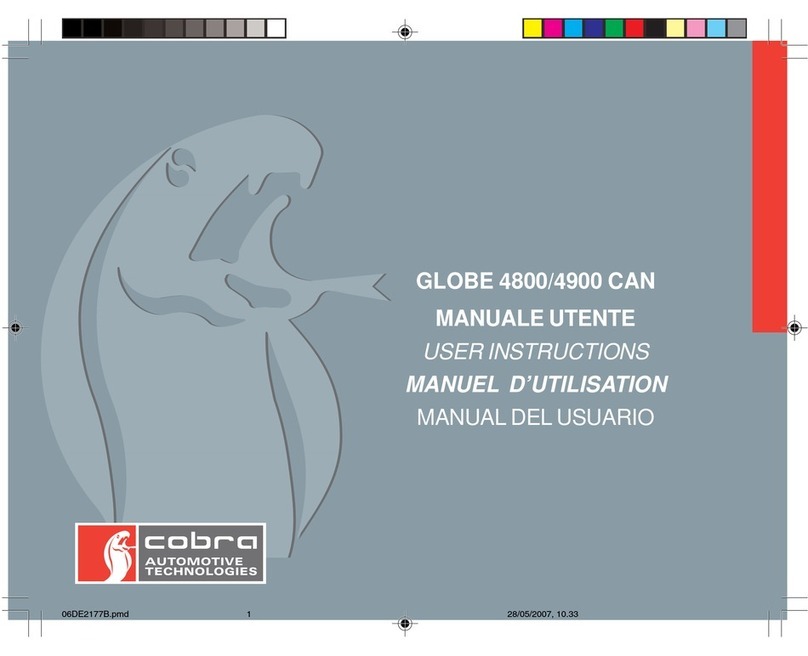
Cobra
Cobra GLOBE 4800 CAN User manual

Cobra
Cobra BRIDGE User manual
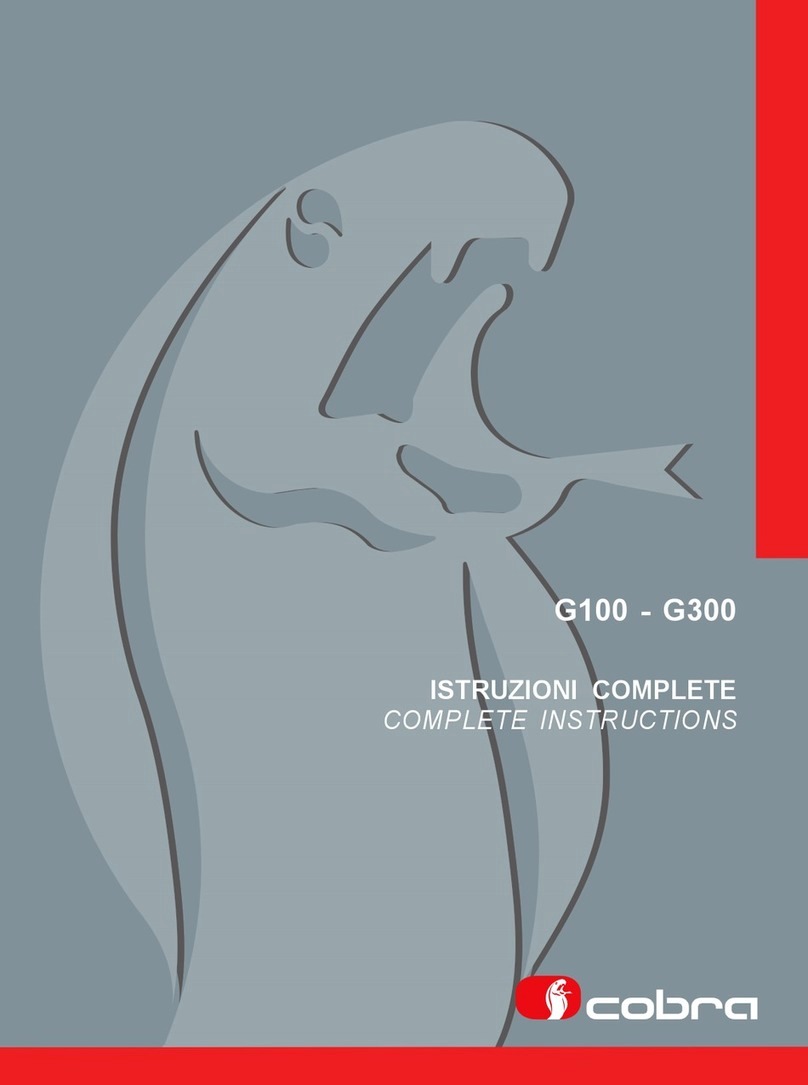
Cobra
Cobra G100 User manual

Cobra
Cobra GLOBE 4800 CAN User manual
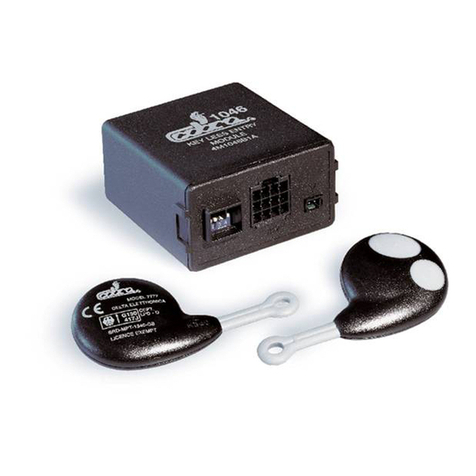
Cobra
Cobra 1046 User manual

Cobra
Cobra GLOBE 4800 CAN User manual

Cobra
Cobra GLOBE 3900 Installation instructions
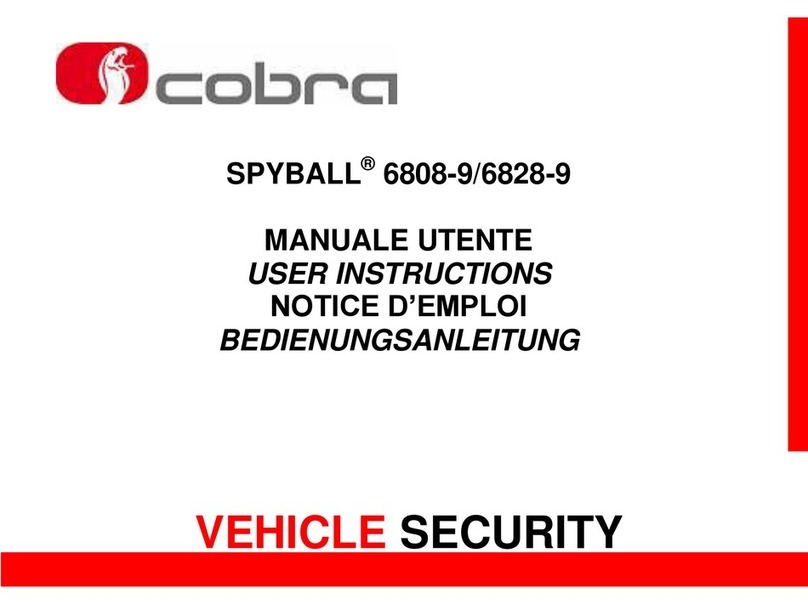
Cobra
Cobra SPYBALL 6808-9 User manual
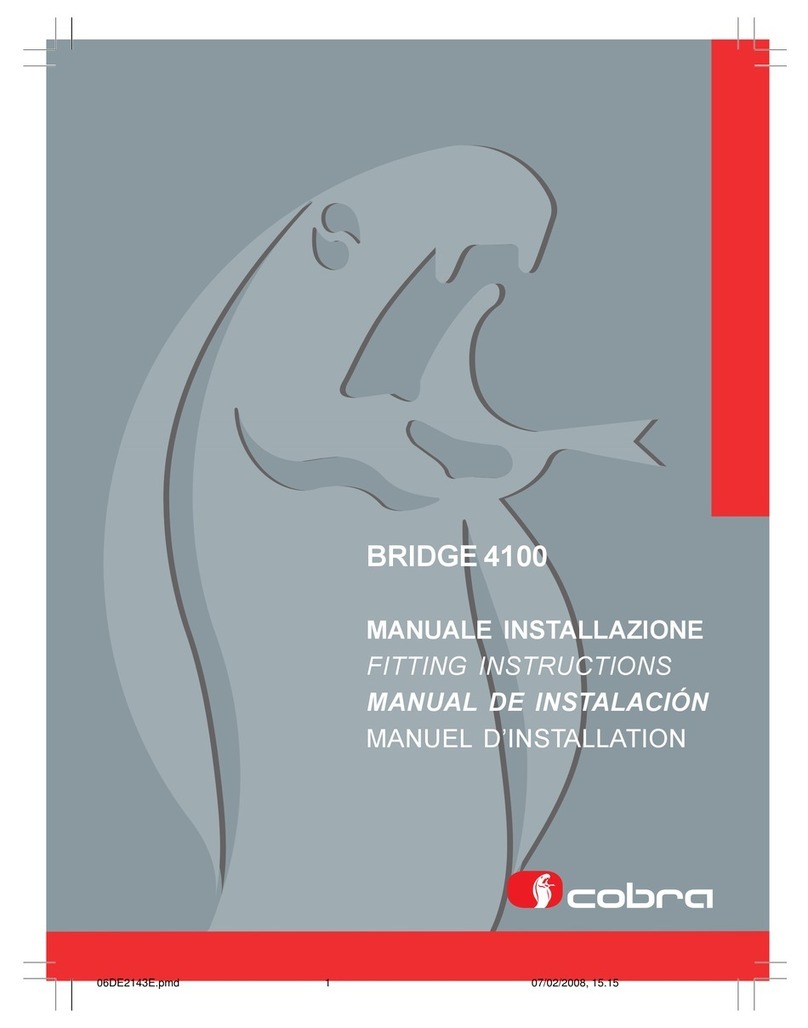
Cobra
Cobra Bridge 4100 User manual

Cobra
Cobra GLOBE 4800 CAN User manual

Cobra
Cobra 8185 User manual
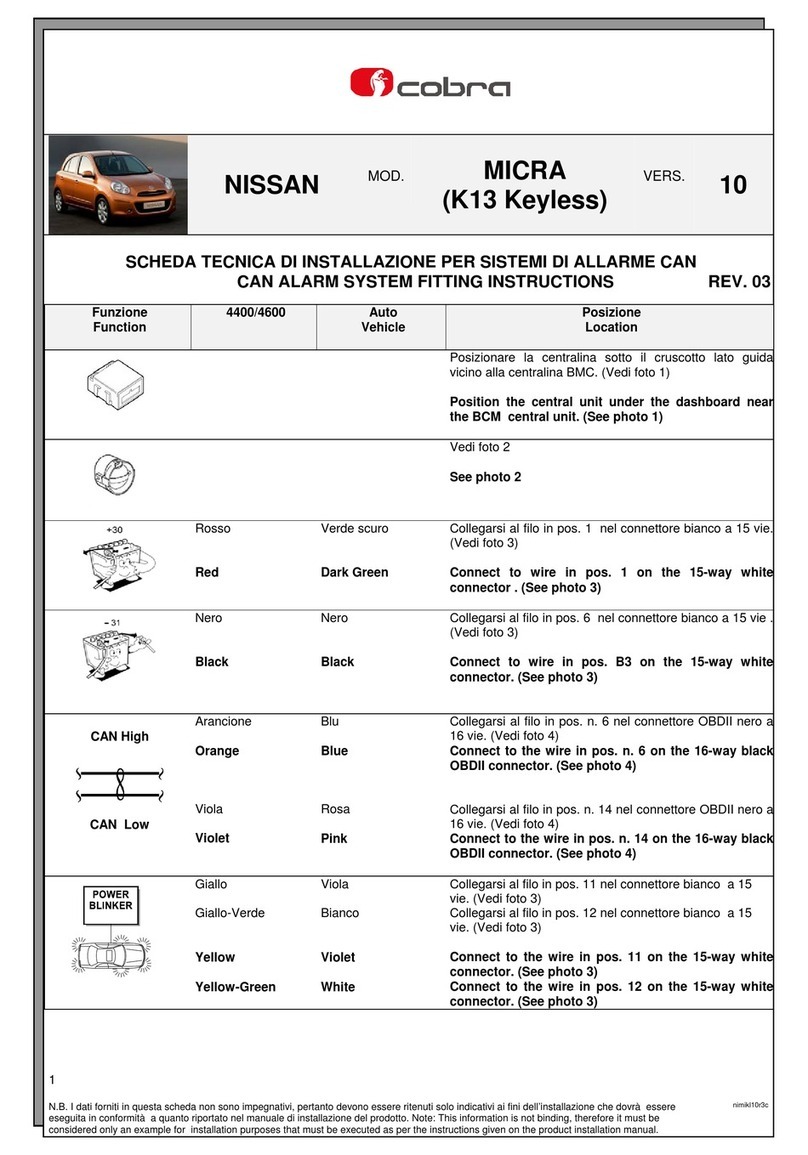
Cobra
Cobra 4400 User manual

Cobra
Cobra Bridge 4100 User manual
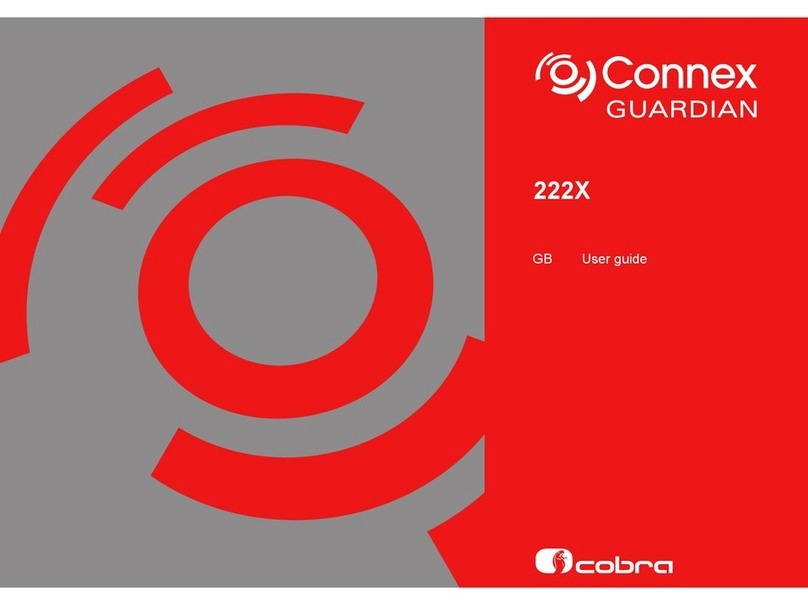
Cobra
Cobra Connex Guardian 222X User manual
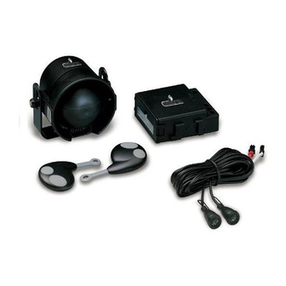
Cobra
Cobra 3198 User manual

Cobra
Cobra Bridge compact alarm User manual

Cobra
Cobra SPYBALL 6829 User manual

Cobra
Cobra G100 User manual
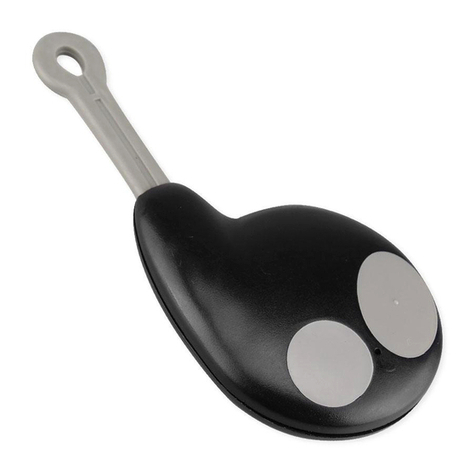
Cobra
Cobra 8165 User manual
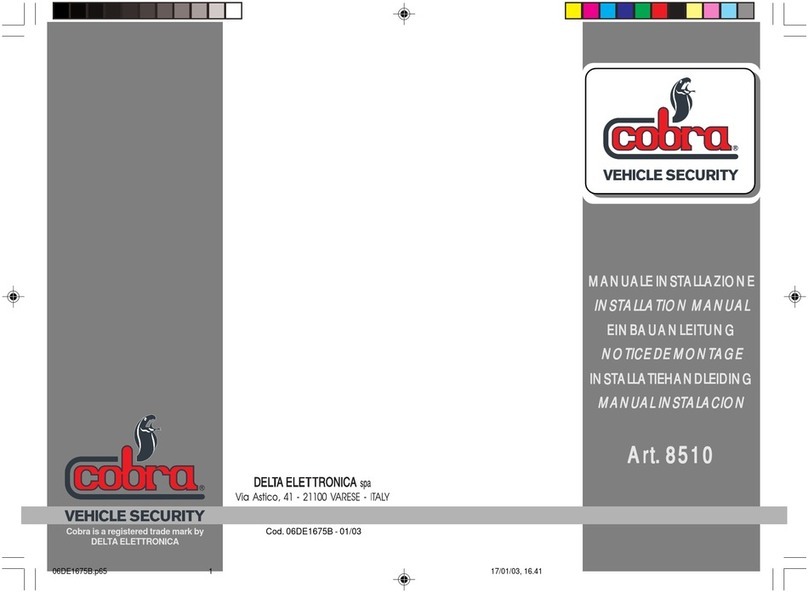
Cobra
Cobra 8510 User manual



